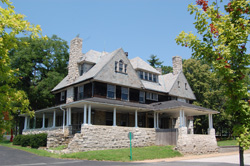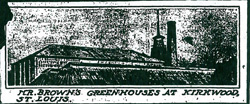Brownhurst on the Market for Only 30 Days
Proponents for the preservation of Brownhurst, situated on the St. John Vianney High School Campus, were given another 30 day stay of demolition. The struggle to save the 119 year old Richardsonian Shingle Style residence began on May 19th, when Vianney applied for a demolition permit. The President of Vianney, John Loyet, believes the buildings should be razed due to the safety issues from the deteriorating building. Before the permit could be issued, it had to be reviewed by the Kirkwood Landmarks Commission (KLC). At the July 13th review meeting, the commission imposed the initial 30 day stay of demolition in order to collect more information about Brownhurst and consult with the city attorney. Esley Hamilton, Preservation Historian for St. Louis County Parks and Recreation attend the July 13th meeting. Afterwards, he projected his disdain for the proposed demolition to the Webster-Kirkwood Times. "This is completely exasperating. It's been demolition by neglect, that's exactly what the fathers have done," Hamilton expressed concerning Brownhurst being intentionally left vacant since 1989. "They allowed it to deteriorate deliberately, so they can tear it down. They couldn't use the building and they refused to let anyone else use it."
 |
| Daniel Sidney Brown's Brownhurst |
After the initial stay of demolition expired, the review of the demolition permit for Brownhurst was reevaluated at the August 10th KLC meeting. During the public comments, Loyet, plus former Vianney students and a priest from the Society of Mary, spoke in favor of the demolition of the building. All stated that Brownhurst creates an unsafe and insecure environment for the students at Vianney. Public comments and deliberation from the commission last nearly two hours. The end result was a second stay of demolition for 30 days. During the allotted time the Landmarks Commission with volunteers would be allowed by Vianney to conduct HABS/HAER documentation of Brownhurst. The commission also hopes an individual or organization would purchase the home and relocate the building. Vianney would be able to proceed with disconnecting and capping the various utilities to prep the building for demolition. However, the commission stated the disconnects would have to be made if rehabilitation became an option. Once the current stay expires on September 9th and a serious offer has not been made, a subsequent stay of demolition will not be filed and Vianney may proceed with the demolition.
The history of Brownhurst began when Daniel Sidney Brown purchased 36 acres in 1888 from Joseph and Laura Branson. The property contained a small farmstead in which Brown, the Vice President of the Pioneer Cooperage Company, planned to demolish for a new residence. During the proceeding years, Brown opted to move the original residence to the rear of the property and began construction of his new dwelling. His new home was completed in 1892 and consisted of a 12 room limestone and frame dwelling designed in the Shingle style. By the turn of the twentieth century, Brownhurst grew to a 140 acre country estate composed of artificial lakes, three barns, two conservatories and a Japanese garden. On this property he grew many species of flora which included over 3,500 species of orchids and an extensive orchard. Brown's gardens were so renowned that they became a popular day trip and side-attraction for visitors to the World's Fair. Throughout the years, Brown donated several specimens from his estate to the Missouri Botanical Garden. These specimens included several palms that were planted in the Garden's Palm House in 1913.
 |
| Brown's Greenhouses from Post-Dispatch 1906 |
Brown sold his expansive country estate in 1917 to realtor Benjamin Brinkman. The decision was made in part due to restrictions on coal during World War I. Unable to heat his massive greenhouses during the winter, Brown donated a large portion of his collection to the Missouri Botanical Garden. The Brown's relocated to 5221 Washington Avenue. Daniel Brown died two years later after leaving Brownhurst. As a sign of respect, The Missouri Botanical Gardens sent a floral blanket to his funeral consisting of 150 blooms of lady slipper orchids and single cattleya orchid, all of which were donated by Brown to the Garden.
Weeks after Brinkman purchased the Brownhust estate, he began to reduce his holdings. He sold 40 acres at the southwest corner of Kirkwood and Big Bend Roads to the Society of Mary. The society intended to develop the site for Chaminade College. Another 40 acres to the south, which included Brownhurst, sold to attorney Ernest Rombauer. During the subsequent years, Brownhurst was purchased by the Society of Mary and St. John Vianney High School was constructed south of the dwelling in 1960. The home was used for storage by the school until it was vacated in 1989.
The St. John Vianney High School and the Society of Mary are currently accepting serious bids for the purchase of Brownhurst. The school can be reached at 314-965-4853. The Society of Mary, whom own Brownhurst, can be contacted at 314-533-1207
***Research concerning Brownhurst conducted by Landmarks intern and Savannah College of Art and Design Historic Preservation Graduate Student, Katie Graebe.
